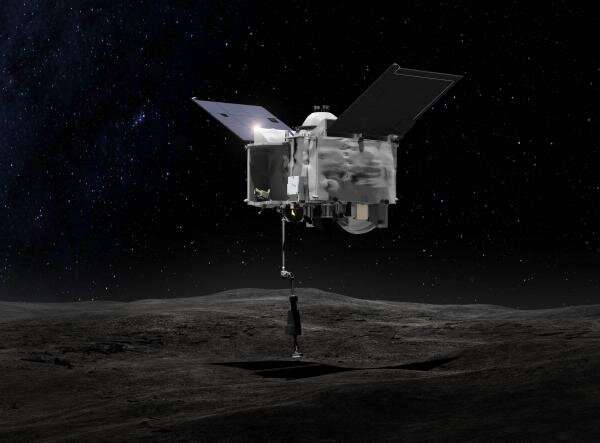Artist’s concept of OSIRIS-REx collecting its asteroid sample. Credit: NASA
The OSIRIS-REx spacecraft has been at Bennu since Dec. 3, 2018, mapping the asteroid in detail, while the mission team searches for a sample collection site that is safe, conducive to sample collection, and worthy of closer study. One of the biggest challenges of this effort is that Bennu has an extremely rocky surface and each boulder presents a danger to the spacecraft's safety as it touches down and grabs a sample.
To expedite the sample selection process, the Planetary Science Institute has been funded to develop a hazard map by flagging boulders identified by the public. This will be accomplished by the CosmoQuest program, developed and directed by PSI Senior Scientist Pamela L. Gay, a pioneer of citizen science on the web.
You can help find the best place on asteroid Bennu to collect a sample for return to Earth for study by going to Bennu.cosmoquest.org and marking the locations of small rocks, boulders, and craters in high resolution images. In addition to finding safe places to grab a rock, your data will also help identify other scientifically interesting features on the asteroid.
"CosmoQuest was the first citizen science platform to achieve surface science results from the general public that are comparable to those of professionals," said Gay. "This is precision work but not difficult work. You need a larger screen so you can use a mouse or track pad to make accurate marks. There is an interactive tutorial to teach you everything you need to know, and the CosmoQuest team is here to help you."
"For the safety of the spacecraft, the mission team needs a comprehensive catalog of all the boulders near the potential sample collection sites, and I invite members of the public to assist the OSIRIS-REx mission team in accomplishing this essential task," said Dante Lauretta, OSIRIS-REx principal investigator at the University of Arizona in Tucson.
The mission's Touch-and-Go (TAG) sampling maneuver is scheduled for July 2020, and the spacecraft will return to Earth with its cargo in September 2023.
Provided by Planetary Science Institute
























